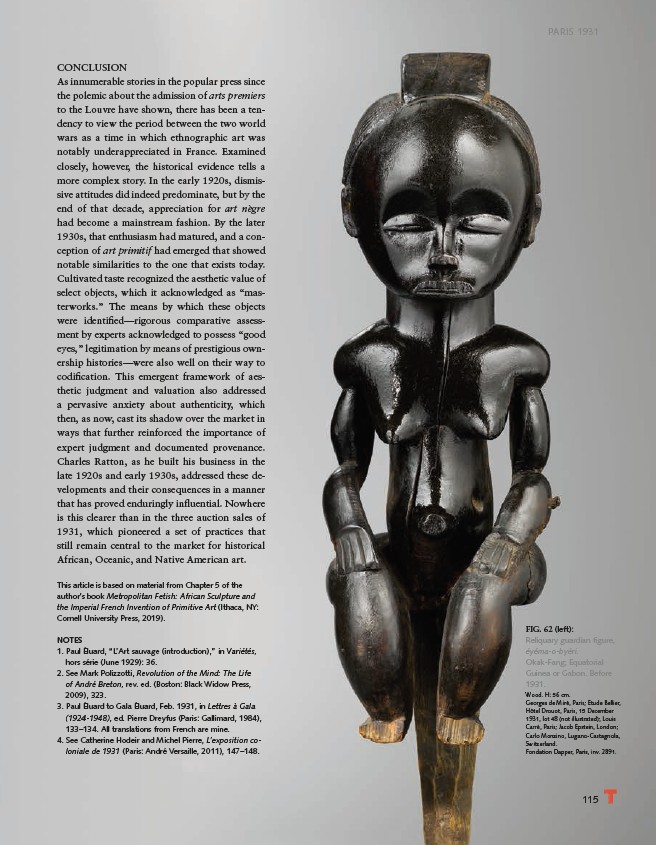
PARIS 1931
FIG. 62 (left):
Reliquary guardian figure,
éyéma-o-byéri.
Okak-Fang; Equatorial
Guinea or Gabon. Before
1931.
Wood. H: 56 cm.
Georges de Miré, Paris; Étude Bellier,
Hôtel Drouot, Paris, 15 December
1931, lot 48 (not illustrated); Louis
Carré, Paris; Jacob Epstein, London;
Carlo Monzino, Lugano-Castagnola,
Switzerland.
Fondation Dapper, Paris, inv. 2891.
115
CONCLUSION
As innumerable stories in the popular press since
the polemic about the admission of arts premiers
to the Louvre have shown, there has been a tendency
to view the period between the two world
wars as a time in which ethnographic art was
notably underappreciated in France. Examined
closely, however, the historical evidence tells a
more complex story. In the early 1920s, dismissive
attitudes did indeed predominate, but by the
end of that decade, appreciation for art nègre
had become a mainstream fashion. By the later
1930s, that enthusiasm had matured, and a conception
of art primitif had emerged that showed
notable similarities to the one that exists today.
Cultivated taste recognized the aesthetic value of
select objects, which it acknowledged as “masterworks.”
The means by which these objects
were identified—rigorous comparative assessment
by experts acknowledged to possess “good
eyes,” legitimation by means of prestigious ownership
histories—were also well on their way to
codification. This emergent framework of aesthetic
judgment and valuation also addressed
a pervasive anxiety about authenticity, which
then, as now, cast its shadow over the market in
ways that further reinforced the importance of
expert judgment and documented provenance.
Charles Ratton, as he built his business in the
late 1920s and early 1930s, addressed these developments
and their consequences in a manner
that has proved enduringly influential. Nowhere
is this clearer than in the three auction sales of
1931, which pioneered a set of practices that
still remain central to the market for historical
African, Oceanic, and Native American art.
This article is based on material from Chapter 5 of the
author’s book Metropolitan Fetish: African Sculpture and
the Imperial French Invention of Primitive Art (Ithaca, NY:
Cornell University Press, 2019).
NOTES
1. Paul Éluard, “L’Art sauvage (introduction),” in Variétés,
hors série (June 1929): 36.
2. See Mark Polizzotti, Revolution of the Mind: The Life
of André Breton, rev. ed. (Boston: Black Widow Press,
2009), 323.
3. Paul Éluard to Gala Éluard, Feb. 1931, in Lettres à Gala
(1924-1948), ed. Pierre Dreyfus (Paris: Gallimard, 1984),
133–134. All translations from French are mine.
4. See Catherine Hodeir and Michel Pierre, L’exposition coloniale
de 1931 (Paris: André Versaille, 2011), 147–148.